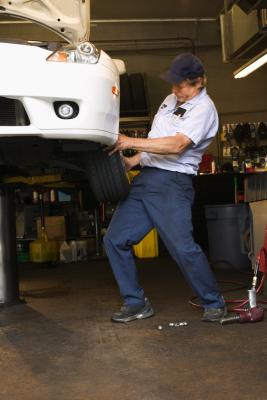
Tire rotation and wheel alignment are both essential parts of maintaining your car. Even though both procedures relate to wheels and tires, they serve quite different purposes. Neither should be considered a substitute for the other. Getting your tires rotated and wheels aligned when required ensures that your car will handle correctly and preserve the life of your tires.
When you drive your car, wear is placed on each tire in a slightly different way. This has to do with the different ways that cars put more pressure on some wheels than others based on the type of vehicle or how it is used. Rotate the tires regularly to ensure that all four tires wear out with a similar pattern. This works because the rotation subjects each tire to all possible positions of stress.
Wheel alignment is performed to the wheels in their current positions on the car. The angle at which the wheel sits is adjusted during the procedure. Three main types of angles are adjusted during this procedure: the camber, caster and toe. Camber refers to the angle of the tire that either leans in toward the car or away from it. Caster is the angle on which the wheels pivot when turning. Toe refers to the angle of the front side of the tire as it relates to the back side.
It is imperative that you do everything you can to make your tires wear evenly. A tire that wears in an uneven fashion can cause your car to pull, cause premature tire failure or can set up vibrations when you drive. Tire rotation is very important for preventing tire wear.
Wheel alignment is not something that needs to be performed regularly but does require regular inspection -- typically once per year. Regularly hitting potholes is just one cause for your vehicle's alignment going out of specification, as they can cause mild distortion to the angles of the wheels with each impact. Rotation needs to be done regularly. Manufacturer suggestions vary, but in general a tire rotation should be performed around every 6,000 miles.